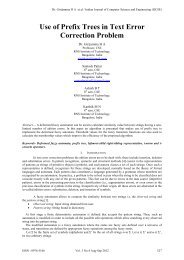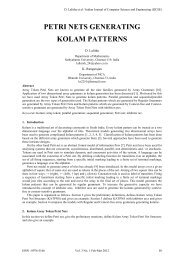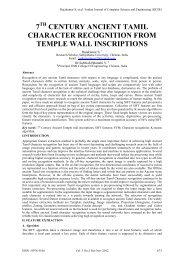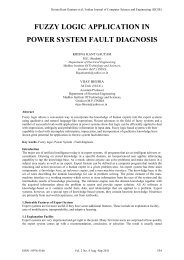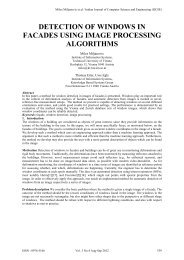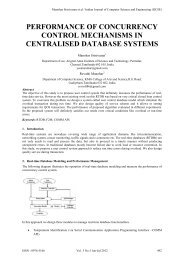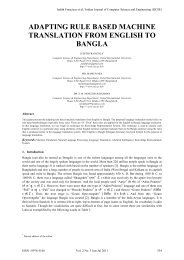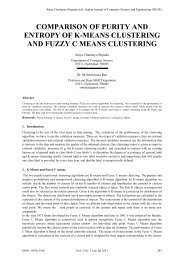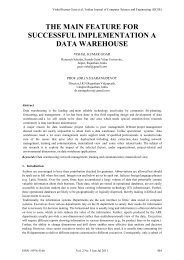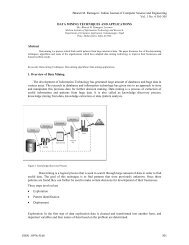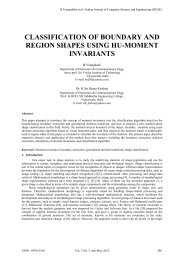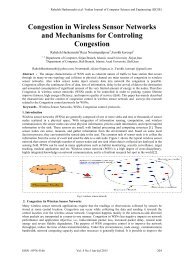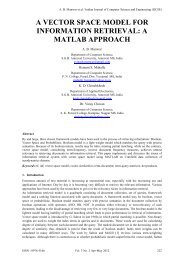automated test cases generation for object oriented software
automated test cases generation for object oriented software
automated test cases generation for object oriented software
Create successful ePaper yourself
Turn your PDF publications into a flip-book with our unique Google optimized e-Paper software.
A.V.K.Shanthi et al./ Indian Journal of Computer Science and Engineering (IJCSE)<br />
Analysis based on above operators our proposed identify 100% bugs based on obtained <strong>test</strong> <strong>cases</strong> and<br />
path can be analyzed based on obtained <strong>test</strong> <strong>cases</strong>.<br />
7. Conclusion<br />
In recent trend Model-Based <strong>test</strong> case attracts many researchers by using some data mining concept to<br />
produce an <strong>automated</strong> optimal <strong>test</strong> case. By which human and cost ef<strong>for</strong>t are minimized. Since <strong>test</strong> case<br />
<strong>generation</strong> from design specifications has the added advantage of allowing <strong>test</strong> <strong>cases</strong> to be available<br />
early in the <strong>software</strong> development cycle, UML Class diagram is used. Our approach using class<br />
diagram in UML Model, Comparatively with Evolutionary Genetic Algorithm yields optimal valid <strong>test</strong><br />
<strong>cases</strong> than with only genetic crossover operator, after Applying Depth First Searching algorithm.<br />
There are various advantages: Specification-based <strong>test</strong>ing uses in<strong>for</strong>mation derived from a specification<br />
to assist <strong>test</strong>ing as well as to develop program. Evolutionary Genetic Algorithm has been proposed and<br />
implemented to bring out all possible valid <strong>test</strong> <strong>cases</strong> of a given class diagram. Since <strong>test</strong> <strong>cases</strong> are<br />
obtained is valid one so it is not mandatory to evaluate manually.<br />
Reference<br />
[1] M.Prasanna, S.N.Sivanandam, Venkatesan, R.Sundarrajan,15, 2005,"A SURVEY ON AUTOMATIC TEST CASE<br />
GENERATION", Academic Open Internet Journal.<br />
[2] Baikuntha Narayan Biswal, Pragyan Nanda, Durga Prasad Mohapatra, 2008 IEEE, "A Novel Approach <strong>for</strong> Scenario-Based<br />
Test Case Generation",International Conference on In<strong>for</strong>mation Technology.<br />
[3] Chang-ai Sun, 2008 IEEE, "Trans<strong>for</strong>mation-based Approach to Generating Scenario-<strong>oriented</strong> Test Cases from UML<br />
Activity Diagrams <strong>for</strong> Concurrent Applications", Annual IEEE International Computer Software and Applications<br />
Conference.<br />
[4] Bin Lei, Linzhang Wang, "Xuandong Li, UML Activity Diagram Based Testing of Java Concurrent Programs <strong>for</strong> Data<br />
Race and Inconsistency ", 2008 International Conference on Software Testing, Verification, and Validation.<br />
[5] P. Samuel, R. Mall, A.K. Bothra,2008 "Automatic <strong>test</strong> case <strong>generation</strong> using unified modeling language (UML) state<br />
diagrams ",Published in IET Software.<br />
[6] Emanuela G. Cartaxo, Francisco G. O. Neto and Patr´ıcia D. L. Machado, "Test Case Generation by means of UML<br />
Sequence Diagrams and Labeled Transition Systems", IEEE 2007.<br />
[7] Hyungchoul Kim, Sungwon Kang, Jongmoon Baik, Inyoung Ko, "Test Cases Generation from UML Activity Diagrams ",<br />
Eighth ACIS International Conference on Software Engineering, Artificial Intelligence, Networking, and<br />
Parallel/Distributed Computing.<br />
[8] Supaporn Kansomkeat and Sanchai Rivepiboon, "Automated-Generating Test Case Using UML Statechart Diagrams<br />
",SAICSIT 2003.<br />
[9] Santosh Kumar Swain, Durga Prasad Mohapatra, and Rajib Mall, "Test Case Generation Based on Use case and Sequence<br />
Diagram", Int.J. of Software Engineering, IJSE Vol.3 No.2 July 2010<br />
[10] P. McMinn and M. Holcombe. Evolutionary <strong>test</strong>ing of statebased programs. In GECCO, pages 1013–1020, 2005.<br />
[11] B. Meyer. Design by contract. IEEE Computer, 25(10):40– 51, 1992.<br />
[12] Z. Michalewicz. Genetic algorithms + data structures = evolution programs (3rd ed.). Springer-Verlag, London, UK,<br />
1996.<br />
[13] M. Mitchell. An Introduction to Genetic Algorithms. MIT Press, Cambridge, MA, USA, 1998.<br />
[14] J. Offutt and A. Abdurazik. Generating <strong>test</strong>s from UML specifications. In UML, pages 416–429, 1999.<br />
[15] J. Offutt, S. Liu, A. Abdurazik, and P. Ammann. Generating <strong>test</strong> data from state-based specifications. Softw. Test., Verif.<br />
Reliab., 13(1):25–53, 2003.<br />
[16] R. P. Pargas, M. J. Harrold, and R. Peck. Test-data <strong>generation</strong> using genetic algorithms. Softw. Test., Verif. Reliab.,<br />
9(4):263–282, 1999.<br />
[17] P. Tonella. Evolutionary <strong>test</strong>ing of classes. In ISSTA, pages 119–128, 2004.<br />
[18] N. Tracey, J. Clark, and K. Mander. Automated program flaw finding using simulated annealing. In ISSTA ’98, pages 73–<br />
81. ACM Press, 1998.<br />
[19] N. Tracey, J. A. Clark, K. Mander, and J. A. McDermid. An <strong>automated</strong> framework <strong>for</strong> structural <strong>test</strong>-data <strong>generation</strong>. In<br />
ASE, pages 285–288, 1998.<br />
[20] N. J. Tracey. A search-based <strong>automated</strong> <strong>test</strong>-data <strong>generation</strong> framework <strong>for</strong> safety-critical <strong>software</strong>. PhD thesis, University<br />
of York, 2000.<br />
ISSN : 0976-5166 Vol. 2 No. 4 Aug -Sep 2011 546



